
Nepenthes reinwardtiana is a tropical pitcher plant native to Borneo and Sumatra and to a number of smaller surrounding islands including Bangka, Natuna, Nias, and Siberut. Although some sources have included Peninsular Malaysia and Singapore within the range of this species, these records appear to be erroneous.

Nepenthes spathulata is a tropical pitcher plant native to Java and Sumatra, where it grows at elevations of between 1100 and 2900 m above sea level. The specific epithet spathulata is derived from the Latin word spathulatus, meaning "spatula shaped", and refers to the shape of the lamina.

Nepenthes campanulata, the bell-shaped pitcher-plant, is a tropical pitcher plant native to Borneo. It has also been reported from Palawan, the Philippines, though further field work is needed to confirm this identification.

Nepenthes adnata is a tropical pitcher plant endemic to the Indonesian province of West Sumatra, where it grows at elevations of 600 to 1200 m above sea level. The specific epithet adnata is Latin for "broadly attached" and refers to the base of the lamina.

Nepenthes angasanensis is a tropical pitcher plant species endemic to Sumatra, where it grows at an altitude of 1,400 metres (4,600 ft) to 3,100 metres (10,200 ft) above sea level. The status of this taxon is controversial as it is similar in morphology to N. mikei and N. tobaica. It has even been suggested that the taxon might represent a natural hybrid between N. densiflora and N. tobaica.
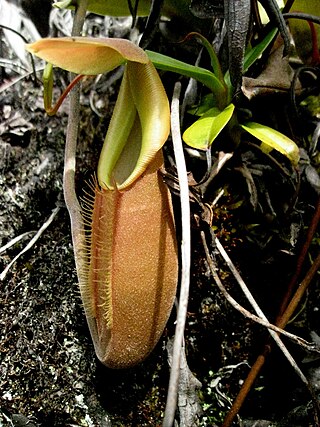
Nepenthes bongso is a tropical pitcher plant endemic to Sumatra, where it has an altitudinal distribution of 1000–2700 m above sea level. The specific epithet bongso refers to the Indonesian legend of Putri Bungsu, the spirit guardian of Mount Marapi.
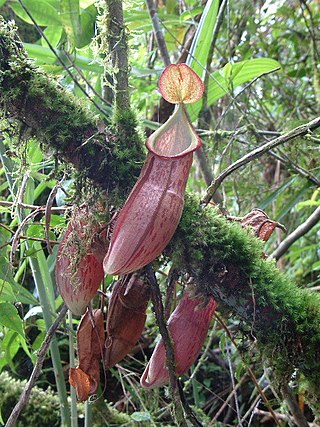
Nepenthes gymnamphora is a tropical pitcher plant native to the Indonesian islands of Java and Sumatra. It has a wide altitudinal range of 600–2,800 metres (2,000–9,200 ft) above sea level. There is much debate surrounding the taxonomic status of this species and the taxa N. pectinata and N. xiphioides.

Nepenthes eustachya is a tropical pitcher plant endemic to Sumatra, where it grows from sea level to an elevation of 1600 m. The specific epithet eustachya, formed from the Greek words eu (true) and stachys (spike), refers to the racemose structure of the inflorescence.
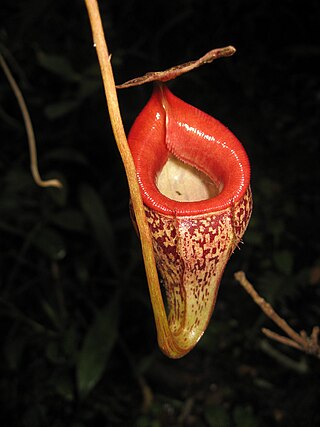
Nepenthes talangensis is a tropical pitcher plant endemic to Sumatra, where it grows in upper montane forest at elevations of 1800–2500 m above sea level.
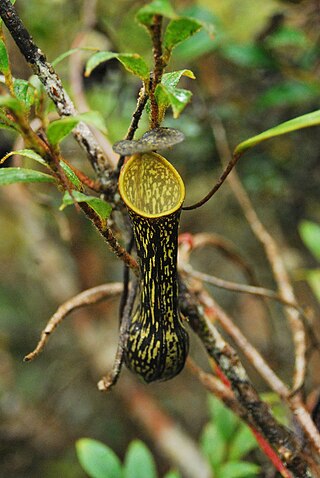
Nepenthes mikei is a tropical pitcher plant endemic to Sumatra. It is characterised by its black mottled lower and upper pitchers. The species is closely related to N. angasanensis and N. tobaica.

Nepenthes tobaica is a tropical pitcher plant endemic to Sumatra. It is particularly abundant around Lake Toba, after which it is named.
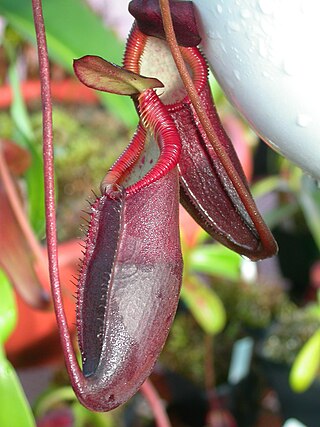
Nepenthes diatas is a tropical pitcher plant endemic to Sumatra, where it grows at an altitude of 2,000–2,900 metres (6,600–9,500 ft) above sea level.

Nepenthes singalana is a tropical pitcher plant endemic to the island of Sumatra, where it grows at 2000–2900 m above sea level. It is most closely allied to N. diatas and N. spathulata.
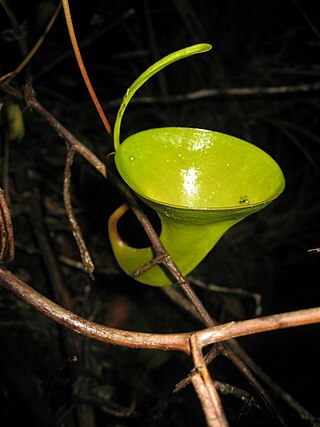
Nepenthes inermis is a tropical pitcher plant endemic to the Indonesian island of Sumatra. The specific epithet inermis is Latin for "unarmed" and refers to the upper pitchers of this species, which are unique in that they completely lack a peristome.

Nepenthes rhombicaulis is a tropical pitcher plant endemic to Sumatra. The specific epithet rhombicaulis is formed from the Latin words rhombicus, meaning "rhomboid", and caulis, "stem". It refers to the cross-sectional shape of the stem internodes.

Nepenthes ovata is a tropical pitcher plant endemic to Sumatra. The specific epithet ovata is Latin for "ovate" and refers to the shape of the lower pitchers.
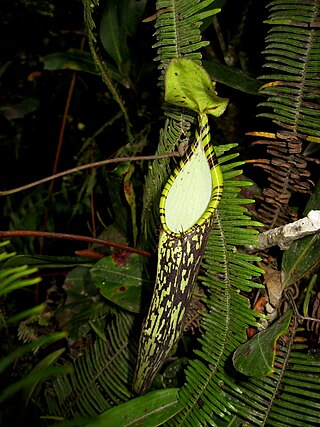
Nepenthes spectabilis is a tropical pitcher plant endemic to Sumatra, where it grows at elevations of between 1400 and 2200 m above sea level. The specific epithet spectabilis is Latin for "visible" or "notable".

Nepenthes × hookeriana, or Hooker's pitcher-plant, is a common natural hybrid involving N. ampullaria and N. rafflesiana. It was originally described as a species.

Nepenthes × pyriformis is a natural hybrid involving N. inermis and N. talangensis. It is known only from Mount Talang in Sumatra, to which N. talangensis is endemic. Nepenthes talangensis was only described as a distinct species in 1994. Prior to this it was placed within N. bongso and some of the older literature identifies this hybrid as N. bongso × N. inermis.



















